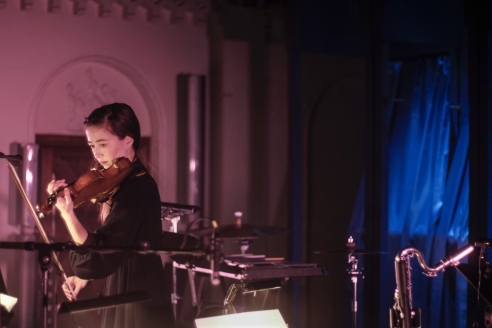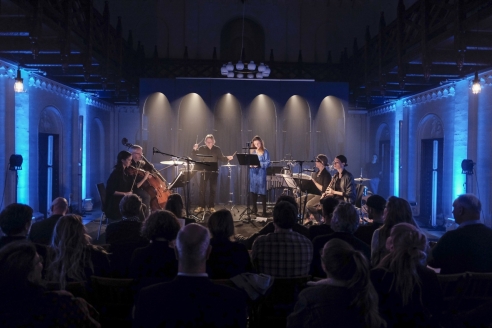
Figura Festspiele
»It’s more a story than a song«, wrote the Czech composer Jiří Slabihoudek of his piece Standing by a tomb of RL Stevenson in Samoa. Its windy [sic] on the sheet of paper that was handed out before we heard it performed at Figura Festspiele.
»More a story than a song«. Those words could apply to almost all the works I heard over three concerts at Bygningskulturens Hus during this years edition of Figura Festspiele. But they were particularly apt in the case of Slabihoudek’s piece. It is hard to know for sure if we’d have sensed so clearly the faltering winds at work in his score without more words from his programme note: »suddenly the wind arises and bring with it two poems…«. But we did hear something of the wind in mezzo-soprano Helene Gjerris’s gentle humming and in the cyclic ostinato that Slabihoudek invented, then disrupted or let slip through aural fingers – as fleeting as the breeze itself.
Asmussen was asked not just to sing and speak, but to blow (a large bottle, a pitchless trumpet)
More important than Slabihoudek conjuring-up breezes in his piece – and his doing so largely without recourse to actual wind noises (plenty of those elsewhere across Figura’s festival) – was the idea of time and place, of imagination. Those things explained his reference to a ‘story’. The piece opened with a form of musical »der var engang…«, which is as good a way as any to endear yourself to your listeners whatever the musical grammar. It closed, after the line »the hunter home from the hill« (from one of two Stevenson poems), with a characteristic Nordic ending in which the music shuffled off without saying goodbye.
The wind comes and it goes, a little like the impressionistic memories described by the British composer Robert Durnin and at work in his piece Clarities. But here, clarity arrives only when images or recollections align. The steady fragments in Durnin’s score eventually settled into their groove to form the picture. No sooner had they done so than the picture disappeared; the music stopped.
A defined space
There have been similar effects in Nicolai Worsaae’s music, as in the recent quartet Squawk in which disparate sounds begin to coalesce into a polyphonic weave. As Figura’s format dictates, Worsaae’s Wesenheit ab Wesenheit was scored for the same combination of clarinets, percussion, double bass and voice as those by Durnin and Slabihoudek, but for this work Worsaae added his own electronics while mezzo Helene Gjerris stepped out, replaced by soprano Signe Asmussen.
Asmussen was asked not just to sing and speak, but to blow (a large bottle, a pitchless trumpet) and hit (various objects with a screwdriver) while percussionist Frans Hansen moved from his drum kit to ‘junkyard percussion’ including a bicycle wheel on the other side of the stage. Despite that array of instruments, Worsaae treated potential noise with painstaking care, like a chef selecting ingredients. His story – as evocative as Slabihoudek’s if not as sonically immediate – demanded it: poems written by a German, Jörg Meyer, held in isolation in a Danish prison, collected by his acquaintance, the prison’s chaplain, the composer’s father.
We could "hear" the isolation in the piece, but not in the most obvious ways
We could "hear" the isolation in the piece, but not in the most obvious ways. More than in the silence, there was emptiness in the music’s fascination with just a handful of objects – objects in sound as well as those tangible objects mentioned in the text. The music could be real (as when the double bass became some tiny, scurrying insect) or unreal (like a brain filled with its own delusional noise). But the idea of one person’s realm – and that person’s increasing estrangement from the universe outside – felt just as "real" as the real things did.
The piece did slip onto tracks now and then like its companions in this concert. But that process was direct opposite of Durnin’s: when those tracks dropped away and the alignment between voices and instruments faded, the desolation in Asmussen’s vocals communicated the most acute loneliness of all. Eventually, we were left with nothing but suggestions, and finally just a smell – a presence but not an object.
 Violinist Ayumi Paul on stage. Foto: Jörg Koopmann
Violinist Ayumi Paul on stage. Foto: Jörg Koopmann
Stories without words
Violinist Ayumi Paul told us her own story direct from the stage: last October she and graphic artist Sophie Madeleine Jaillet »sat in the Canadian Rockies« where Jaillet drew the outlines of the peaks and Paul transformed those drawings into sound, into Mountain Music. »Mountains are constantly moving, so every time you look at one it will be different«, Paul told us. »We decided to experience that change physically.«
The change, of course, is gradual – almost imperceptibly so. In Paul’s violin playing, the shift was more immediate: slight alterations in one pitch on an octave double-stop, giving the idea of two objects (peaks, perhaps) already positioned apart, but moving further apart by degrees. »This performance of Mountain Music can only exist at the sublime intersection of geological and personal timelines«, said the programme note. So was the change we were witnessing here more a human one than a geological one?
Either way, it felt more like a reflection of the experience – the view from the mountain hideout – than of the process. Paul hummed to herself as if cocooned in a cabin, while her arpeggaic figurations on the violin projected a sense of awesome distance and scale. She sounded heartfelt, clean and secure on her instrument and was lit atmospherically from each side.
The ensemble tried to push Gjerris into the hole at every opportunity
Instruments versus voices
The poetry of Figura-member Ursula Andkjær Olsen was scattered across two concerts on Saturday, the first of which saw composer Mette Nielsen presented with the Axel Borup-Jørgensen Composition Prize 2017. We saw her pick up a nice statuette but the DKK 30,000 was presumably transferred electronically. Nielsen’s piece to Olsen’s text Jeg ville ikke falde i det hul had its own theatre of mania, childishness and sprechgesang, all outbursts which Figura’s instruments sewed the seeds of prompting a sort of binary chain-reaction back and forth. In Nielsen’s words: »musikken skifter stemning med ordene, og ordene skifter stemning med musikken.«
Anders Spang Olsen’s Hann gongur í nátt to an unknown text felt more fully formed and fascinating, finding the swing in another four-in-a-bar rhythm, playing some harmonic games and giving us another one of those kooky Nordic endings. Axel Borup-Jørgensen was himself represented by O Bäume, a coiled, arms-length dance for soprano and clarinet. But it was back to Olsen’s words for the afternoon concert’s highlight: Senile Songs by Christos Farmakis – three texts including, to begin, Jeg ville ikke falde i det hul as set by Mette Nielsen.
Farmakis’s setting began and ended with that line gabbled desperately like a mantra, even when Helen Gjerris was breathing in she was still chanting it. As in Nielsen’s piece, the ensemble tried to push Gjerris into the hole at every opportunity: bogus pedal points like cartoon banana skins and sudden outbursts that tried to knock the singer sideways. But the second and third songs brought a sense of balance, settling into Famarkis’s pulse and his 5-note chord chassis. Over vasken hænger spejlet was a sort of scherzo sung over a consistent rhythm with slap bass, the clarinet "mirroring" the vocal line then abandoning it, trembling alone; Et gran salt I din stemme had to hold itself up in the face of the double-bass’s relentless downward slides.
 Mood picture from Bygningskulturens Hus. Foto: Jörg Koopmann.
Mood picture from Bygningskulturens Hus. Foto: Jörg Koopmann.
Under-surface tension
Later that evening, Jakob Davidsen and his orchestra of friends (da: Kammerat Orkester) joined Figura Ensemble for the first performance of six settings of Olsen poems from Det 3 årtusindes hjerte under the title Verden er babel og elfen. Mezzo Tuva Semmingsen raised the bar with her performances, as rich and lyrical in the opening song Jeg kan forestille mig dig as the band was brash and brittle.
With Davidsen highly sensitive at the piano, Peter Fuglsang and Karl Husum full of attitude on clarinet and trumpet, the smoky-toned Semmingsen in the middle and others surrounding her, the atmosphere was suddenly charged in this set of songs that plays with its own series of grooves and often reacts to heartfelt text-setting with fascinating instrumental elaboration. They may have been written down, but the tension of improvisation lay under the surface in all six songs.
They may have been written down, but the tension of improvisation lay under the surface in all six songs
Verden af glas segued from louche cabaret into crazed fairground music; Som was a simmering recitative pushed forward by the ebb and flow of instrumental waves; Verden er babel og elfen saw Semmingsen and the band spit out syllables in concord. Du er mit started as a simple ballad before disintegrating, and sure enough a groove came to the rescue: a ground bass over which a fake improvisation could take root. The lights came up, and then All rise: Semmingsen’s speech over instrumental fragments and then an almighty faux-climax in which Husum blew down a Viking horn.
Verden er babel of elfen is in some sense an exploration of paradoxes, of things that appear opposite to what they actually are: the smooth is deceptive while the brittle is honest; what sounds improvised is carefully chiseled; the elemental climax is a micro-musical joke. And as if to emphasise what is the truths that lie underneath all honest music, the piece was preceded by five exquisite improvisations from Davidsen’s ensemble in which not a single note was wasted.
We heard a lot in these five improvisations, each initiated by one of the ensemble’s instruments (piano, cello, clarinet, trombone, trumpet). But in a sense we didn’t hear a great deal either, just intense listening and organic reaction. There were laughs in the piece initiated by Jakob Munck’s trombone, with its lumbering ostinato and fun with mutes, and there was veiled beauty in the piece initiated and then closed – with the gentlest of postludes – by John Ehde’s cello. But despite all the abstraction of ideas on one instrument inducing reactions on another, it was almost like we were simply listening to five little stories being told.


